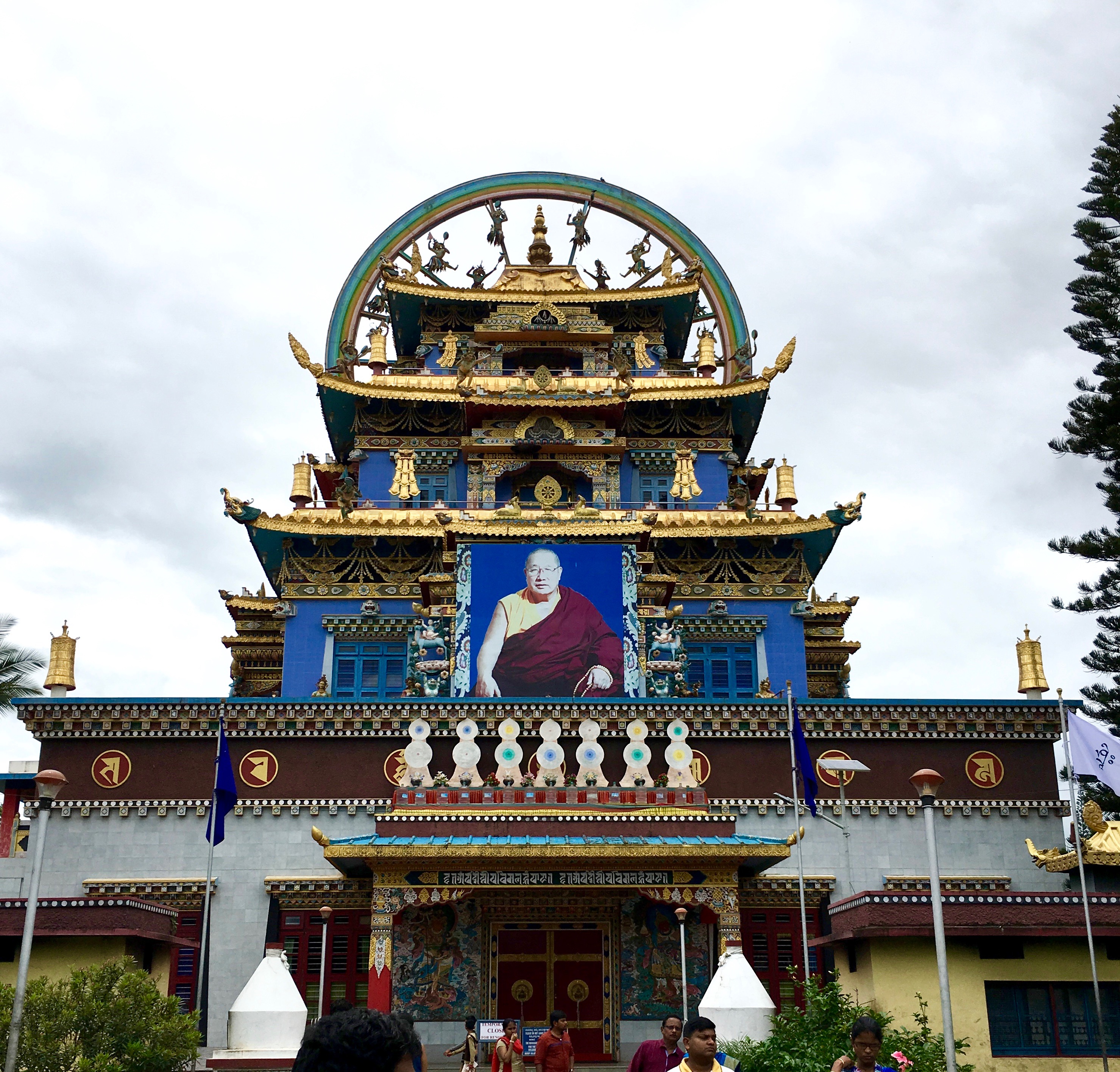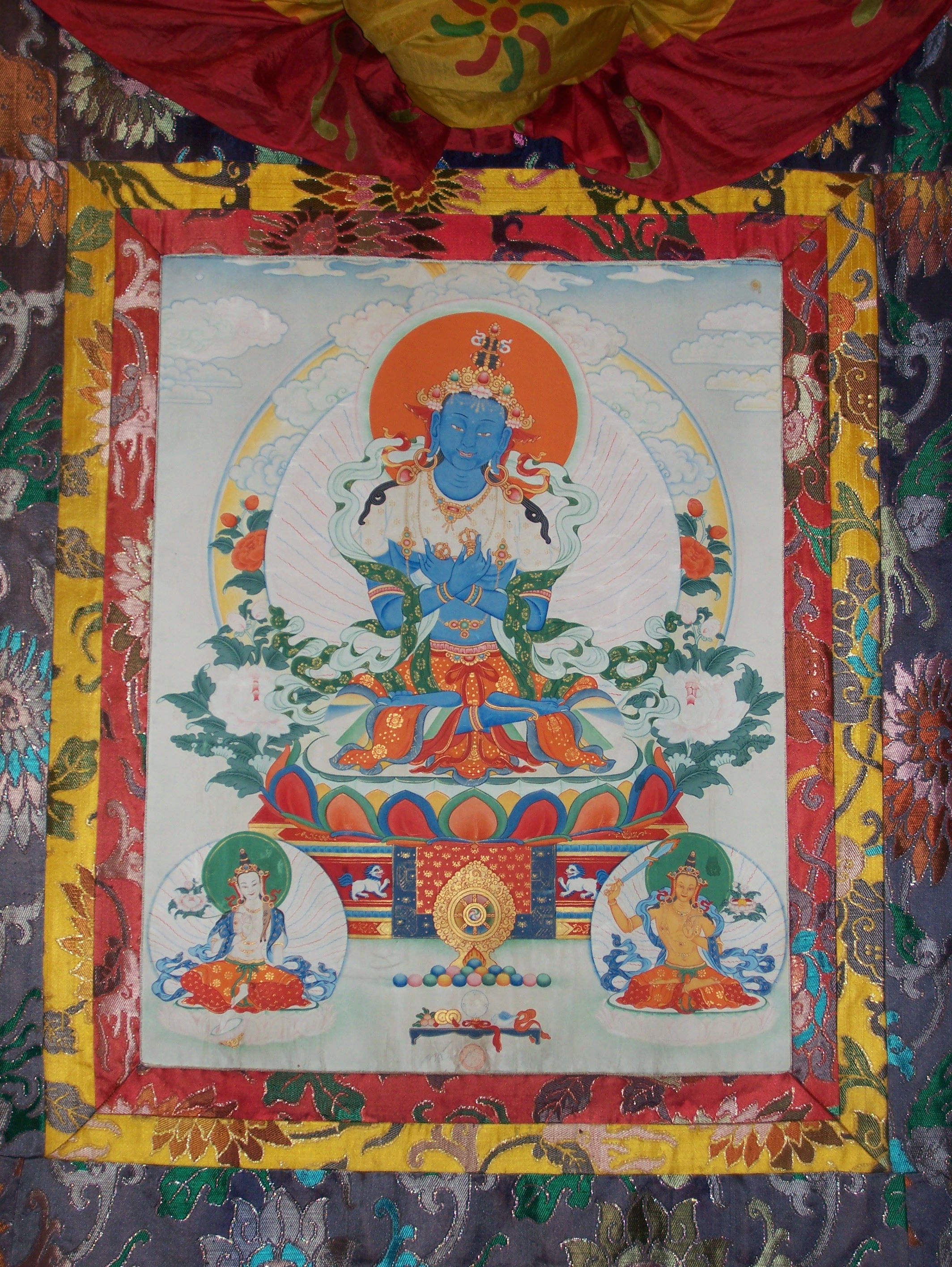|
Palyul
Palyul Monastery (), also known as Palyul Namgyal Jangchub Choling Monastery and sometimes romanized as Pelyul Monastery, is one of the "Six Mother Monasteries" of the Nyingma tradition of Tibetan Buddhism. It was founded in 1665 by Rigzin Kunzang Sherab in Pelyul in Baiyü County, Garzê Tibetan Autonomous Prefecture in China's Sichuan province, on the eastern edge of Tibet in Kham. The monastery is the seat of the Nam Chö Terma of Terton Mingyur Dorje. Drubwang Padma Norbu (Penor Rinpoche) was the 11th throneholder of the Palyul lineage. Upon his mahaparinirvana in March 2009, Karma Kuchen Rinpoche became the 12th throneholder. Namdroling Monastery in Bylakuppe, India, is where the current throneholder to the Palyul lineage has resided since exile from Tibet during Chinese annexation. Dzogchen Lineage of Palyul * Chöku Kuntuzangpo ( Dharmakaya Samantabhadra) * Drugpa Dorjé Changchen ( Vajradhara) * Dorje Sempa ( Vajrasattva) * Thugjé Chenpo Chenrezig ( Avaloki ... [...More Info...] [...Related Items...] OR: [Wikipedia] [Google] [Baidu] |
Penor Rinpoche
Kyabjé 3rd Drubwang Padma Norbu, Lekshe Chokyi Drayang widely known as Penor Rinpoche (, 30 Jan 1933 – 27 Mar 2009), was the 11th throneholder of the Palyul Lineage of the Nyingma school of Tibetan Buddhism, and the 3rd Drubwang Padma Norbu.Sonam Tsering Ngulphu, "3rd Penor, Lekshe Chokyi Drayang", ''Treasury of Lives'', August 2023 He is recognized as the incarnation of Vimalamitra, an 8th century Buddhist Monk. By the age of 17, he had received the corpus of Payul lineage teachings including Dzogchen teachings, and became a renowned Dzogchen master. He began his escape from Tibet in 1959 with 300 people, and only 30 arrived in India. While working alongside laborers, he rebuilt Palyul Monastery in Karnataka, India, where more than 5,000 Nyingma school monks and nuns study. He was one of a very few teachers left from his generation who received all his traditional training in Tibet under the guidance of fully enlightened masters. His rebuilding of the Palyul tradition in exi ... [...More Info...] [...Related Items...] OR: [Wikipedia] [Google] [Baidu] |
Namdroling Monastery
The Thegchog Namdrol Shedrub Dargye Ling(བོད་ཡིག ཐེག་མཆོག་རྣམ་གྲོལ་བཤད་སྒྲུབ་དར་རྒྱས་གླིང་།) (Wylie transliteration, Wylie: ''theg mchog rnam grol bshad sgrub dar rgyas gling''), informally known as Namdroling Monastery (or ನಮ್ಡ್ರೋಲಿಂಗ್ ವಿಹಾರ, Namdroling Vihara) is the largest teaching center of the Nyingma lineage of Tibetan Buddhism in the world. Located in Bylakuppe, part of the Mysuru district of the state of Karnataka, the monastery is home to a Sangha (Buddhism), sangha community of more than five thousand monks and nuns and qualified teachers, a junior high school named Yeshe Wodsal Sherab Raldri Ling, a Buddhist philosophy college or shedra for both monks and nuns, a home for the elderly, and a hospital. History The monastery was established by the 11th throneholder of the Palyul lineage, the 3rd Drubwang Padma Norbu Rinpoche in 1963. It ... [...More Info...] [...Related Items...] OR: [Wikipedia] [Google] [Baidu] |
Palyul Lineage
Palyul Monastery (), also known as Palyul Namgyal Jangchub Choling Monastery and sometimes romanized as Pelyul Monastery, is one of the "Six Mother Monasteries" of the Nyingma tradition of Tibetan Buddhism. It was founded in 1665 by Rigzin Kunzang Sherab in Pelyul in Baiyü County, Garzê Tibetan Autonomous Prefecture in China's Sichuan province, on the eastern edge of Tibet in Kham. The monastery is the seat of the Nam Chö Terma of Terton Mingyur Dorje. Drubwang Padma Norbu (Penor Rinpoche) was the 11th throneholder of the Palyul lineage. Upon his mahaparinirvana in March 2009, Karma Kuchen Rinpoche became the 12th throneholder. Namdroling Monastery in Bylakuppe, India, is where the current throneholder to the Palyul lineage has resided since exile from Tibet during Chinese annexation. Dzogchen Lineage of Palyul * Chöku Kuntuzangpo ( Dharmakaya Samantabhadra) * Drugpa Dorjé Changchen (Vajradhara) * Dorje Sempa (Vajrasattva) * Thugjé Chenpo Chenrezig ( Avalokitesvara ... [...More Info...] [...Related Items...] OR: [Wikipedia] [Google] [Baidu] |
Nyingma
Nyingma (, ), also referred to as ''Ngangyur'' (, ), is the oldest of the four major schools of Tibetan Buddhism. The Nyingma school was founded by PadmasambhavaClaude Arpi, ''A Glimpse of the History of Tibet'', Dharamsala: Tibet Museum, 2013. as the first translations of Buddhist scriptures from Pali and Sanskrit into Tibetic languages, Tibetan occurred in the eighth century. The establishment of Tibetan Buddhism and the Nyingma tradition is collectively ascribed to Khenpo Shantarakshita, Guru Padmasambhava, and King Trisong Detsen, known as ''Khen Lop Chos Sum'' (The Three: Khenpo, Lopon, Chosgyal). The Nyingma tradition traces its Dzogchen lineage from the Adi-Buddha, first Buddha Samantabhadra to Garab Dorje, and its other lineages from Indian mahasiddhas such as Sri Singha and Jnanasutra. Yeshe Tsogyal recorded the teachings. Other great masters from the founding period include Vimalamitra, Vairotsana, and Buddhaguhya. The Nyingma tradition was physically founded at Samye ... [...More Info...] [...Related Items...] OR: [Wikipedia] [Google] [Baidu] |
Baiyü County
Baiyü County or Pelyül (, zh, s=白玉县) is a county in far western Sichuan, China on the border with the Tibet Autonomous Region. It is under the administration of the Garzê Tibetan Autonomous Prefecture. Administrative divisions Baiyü County is divided into 4 Towns of China, towns and 12 Townships of China, townships. Climate Monasteries The Palyul, Palyul Monastery is located in Baiyü County as is the Yarchen Gar, Yarchen Monastery and Katok Monastery. Nyoshul Jonpalung Monastery (; zh, labels=no , s=辽西寺 / 辽西圆林 , p=Liáoxī Sì / Liáoxī yuánlín), founded by Khenpo Ngaga (1879-1941) in 1910, is located in the county's Dzin Valley of Tromtar. It is a Nyingma monastery which is considered a branch of Katok Monastery, Katok. Adzom Gön Monastery (Anzom, Anzom Chogar, 'od gsal theg mchog gling, Osel Tekchok Ling, Osal Tegchogling) is another branch of Katok in the Tromtar (romkok (khrom tar / khrom khog) region. The founder, Adzom Drukpa Drondul P ... [...More Info...] [...Related Items...] OR: [Wikipedia] [Google] [Baidu] |
Terma (religion)
Terma (; "hidden treasure") are various forms of hidden teachings that are key to the Vajrayana of Tibetan Buddhism, and Bon spiritual traditions. In the Vajrayana Nyingma school tradition, two lineages occur: an oral ''Kama lineage'' and a revealed ''Terma lineage''. ''Terma'' teachings were originally concealed by eighth-century Vajrayana masters Padmasambhava and Yeshe Tsogyal, to be discovered by treasure revealers known as tertöns, when the time was ripe. As such, the termas represent a tradition of continuous revelation in the Vajrayana of Tibetan Buddhism. Background The terma tradition of rediscovering hidden teaching is not unique to Tibet. It has antecedents in India and cultural resonances in Hindu Vaishnavism as well. The Vaishnava saint Chaitanya Mahaprabhu is said to have rediscovered a fragment of the ''Brahma Samhita'' in a trance state of devotional ecstasy. There is another occasion involving Chaitanya, who deposited his divine love (''prema'') for ... [...More Info...] [...Related Items...] OR: [Wikipedia] [Google] [Baidu] |
Tibetan Buddhism
Tibetan Buddhism is a form of Buddhism practiced in Tibet, Bhutan and Mongolia. It also has a sizable number of adherents in the areas surrounding the Himalayas, including the Indian regions of Ladakh, Gorkhaland Territorial Administration, Darjeeling, Sikkim, and Arunachal Pradesh, as well as in Nepal. Smaller groups of practitioners can be found in Central Asia, some regions of China such as Northeast China, Xinjiang, Inner Mongolia and some regions of Russia, such as Tuva, Buryatia, and Kalmykia. Tibetan Buddhism evolved as a form of Mahayana, Mahāyāna Buddhism stemming from the latest stages of Indian Buddhism (which included many Vajrayana, Vajrayāna elements). It thus preserves many Indian Buddhist Tantra, tantric practices of the Gupta Empire, post-Gupta Medieval India, early medieval period (500–1200 CE), along with numerous native Tibetan developments. In the pre-modern era, Tibetan Buddhism spread outside of Tibet primarily due to the influence of the Mongol Emp ... [...More Info...] [...Related Items...] OR: [Wikipedia] [Google] [Baidu] |
Garab Dorje
Garab Dorje (c. 665) () was the first human to receive the complete direct transmission teachings of Sutra, Tantra and Dzogchen. The circumstances of his birth are shrouded in different interpretations, with some accounts describing a miraculous birth by a virgin daughter of the king of Uddiyana. Garab Dorje became the first teacher of Dzogchen ("Great Perfection", also called ''Ati Yoga'') teachings. Garab Dorje's core teachings revolve around understanding the nature of the mind as the original Buddha, beyond birth and cessation, emphasizing meditation as a practice of allowing this natural state without seeking, this is the highest teaching in Buddhism. According to the Nyingma school tradition of Tibetan Buddhism Tibetan Buddhism is a form of Buddhism practiced in Tibet, Bhutan and Mongolia. It also has a sizable number of adherents in the areas surrounding the Himalayas, including the Indian regions of Ladakh, Gorkhaland Territorial Administration, D ..., he transmit ... [...More Info...] [...Related Items...] OR: [Wikipedia] [Google] [Baidu] |
Vajrasattva
Vajrasattva (, Tibetan: རྡོ་རྗེ་སེམས་དཔའ། ''Dorje Sempa'', short form: རྡོར་སེམས། ''Dorsem'') is a bodhisattva in the Mahayana and Mantrayana/Vajrayana Buddhist traditions. In Chinese Buddhism and the Japanese Shingon tradition, Vajrasattva is the esoteric aspect of the bodhisattva Samantabhadra and is commonly associated with the student practitioner who, through the master's teachings, attains an ever-enriching, subtle and rarefied grounding in their esoteric practice. In the East Asian esoteric Buddhist Diamond Realm Mandala, Vajrasattva sits to the East near Akshobhya Buddha. In some esoteric lineages, Nagarjuna was said to have met Vajrasattva in an iron tower in South India, and was taught tantra, thus transmitting the esoteric teachings to more historical figures. In Tibetan Buddhism, Vajrasattva is associated with the sambhogakāya and with purification practice. Vajrasattva appears in various Buddhist texts, inc ... [...More Info...] [...Related Items...] OR: [Wikipedia] [Google] [Baidu] |
Vajradhara
Vajradhara (; ; ; ; ; ) is the ultimate primordial Buddha, or Adi-Buddha, according to the Sakya, Gelug and Kagyu schools of Tibetan Buddhism. It is also a name of Indra, because "Vajra" means diamond, as well as the thunderbolt, or anything hard more generally. In the evolution of Indian Buddhism, Buddha Vajradhara gradually displaced Samantabhadra, who is the 'Primordial Buddha' in the Nyingma, or 'Ancient School.' However, the two are metaphysically equivalent. Achieving the 'state of Vajradhara' is synonymous with complete realisation. According to the Kagyu lineage, Buddhā Vajradhara is the primordial Buddha, the Dharmakaya Buddha. He is depicted as dark blue in color, expressing the quintessence of buddhahood itself and representing the essence of the historical Buddha's realization of enlightenment. As such, Buddha Vajradhara is thought to be the supreme essence of all (male) Buddhas; It is the Tantric form of Sakyamuni which is called Vajradhara. Tantras are tex ... [...More Info...] [...Related Items...] OR: [Wikipedia] [Google] [Baidu] |






